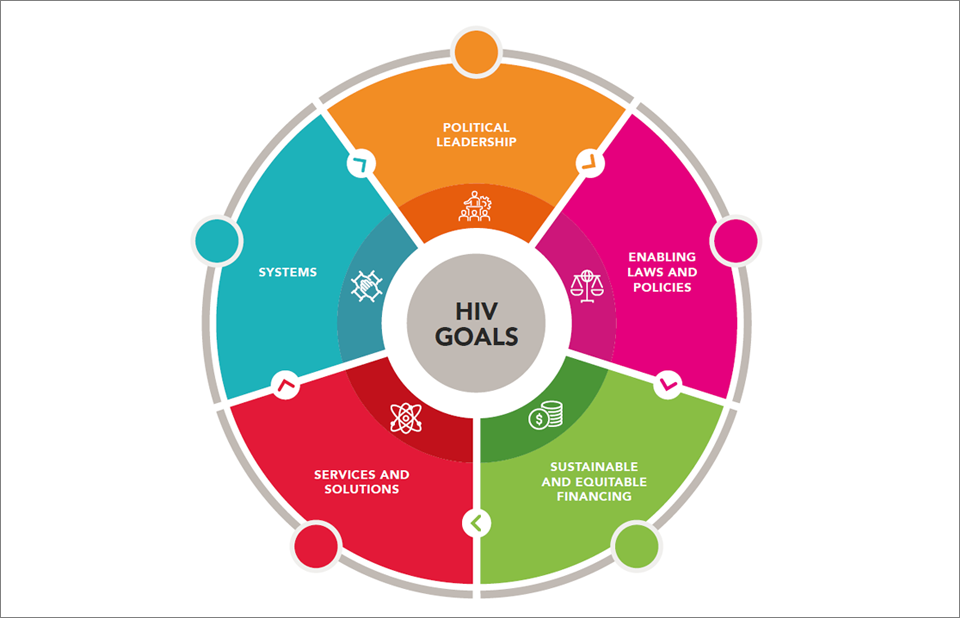FEATURE STORY
There are more people than ever before living with HIV and in need of lifelong treatment (39 million in 2022), with this number set to rise in the coming years. Ensuring long-term resourcing is vital.
However, resources for HIV are severely constrained. In 2022, US$ 20.8 billion was available for HIV programmes in low- and middle-income countries––2.6% less than in 2021 and well short of the US$ 29.3 billion estimated to be needed by 2025. In addition, UNAIDS estimates that in 2022 there was a 90% shortfall in funding for HIV prevention among key populations most affected by HIV, including men who have sex with men, sex workers and people who inject drugs.
As countries work to reach the goal of ending AIDS as a public health threat by 2030, planning is urgently needed to protect and build on the HIV gains made to date, increase efforts to reach people most affected by HIV, and to sustain the HIV response into the future.
This is why UNAIDS has developed an HIV sustainability framework which includes transformations in policy, programmes and systems to sustain the HIV response beyond 2030. To ensure success in sustaining the HIV response, UNAIDS is supporting all stakeholders on long-term planning.
“As the global community pushes towards the ambitious goal of ending AIDS as a public health threat by 2030, a crucial conversation is needed now on how to sustain the hard-won gains of the HIV response well beyond 2030,” said Winnie Byanyima, Executive Director of UNAIDS. “A paradigm shift is needed to ensure the long-term sustainability of the HIV response, a journey that demands transformative action starting today.”
To support countries and partners in implementing the Sustainability Framework as outlined in the UNAIDS HIV response sustainability primer, UNAIDS has released a new Companion Guide which includes country-specific analytical resource packages and a sustainability assessment tool. These resources will serve as tools to help countries and partners develop roadmaps and navigate the path towards sustainability.
The companion guide offers flexible stepwise methodology, allowing each country to tailor the sustainability framework to its unique context. With practical tools and insights, it serves as a compass for initiating and guiding the roadmap development process.
“Developing sustainability roadmaps is key to the HIV sustainability framework and will empower countries to navigate the complex terrain of sustainability,” said Angeli Achrekar, Deputy Executive Director for Programme, UNAIDS.
The country analytical resources package features granular data tables, graphics, and essential fiscal and macroeconomic metrics, broader health system analytics and additional qualitative information. The package serves to facilitate sustainability dialogues essential for planning that fits each country's epidemic characteristics and broader economic and health system landscape.
Central to this journey is also the sustainability assessment tool. This tool empowers stakeholders to identify and address risks across political, structural, financial, and programmatic domains. It also facilitates the discovery of new strategies to enhance the HIV response and drive continuous improvement towards 2030 and beyond.
“Through its intuitive interface, the sustainability assessment tool will help countries understand how to ensure that their HIV response is sustainable – identify the big milestones needed and to organize how to get there,” said Christine Stegling, Deputy Executive Director, Policy, Advocacy and Knowledge Branch, UNAIDS.
Sustainability to 2030 and beyond will require strong political leadership across multiple sectors, and the active engagement of people living with HIV and of key and vulnerable populations. Resources will need to be mobilized from both domestic and international sources, and flexibility and resilience will be required as epidemics evolve, and shifts occur in changing economic, political and social contexts.
UNAIDS will work side by side with countries and partners to enable them to successfully implement the new sustainability framework, so that all people living with and affected by HIV can continue accessing the lifesaving HIV services they need, have their rights protected, and be able to thrive.
